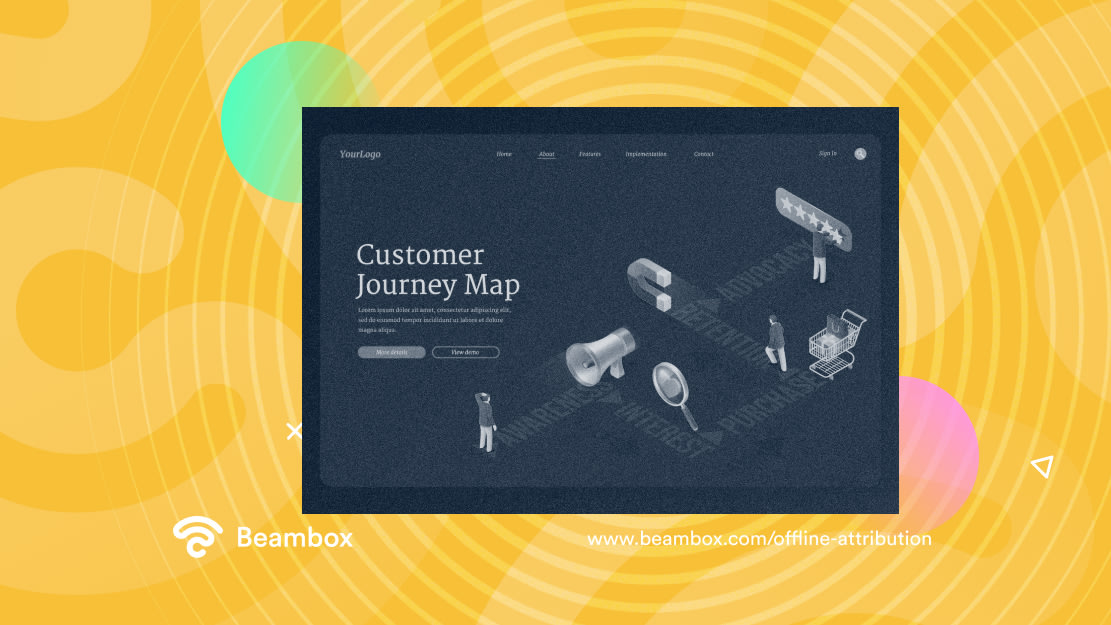Offline Attribution: The Ultimate Guide for Business Owners
“Was it the Facebook ad or the billboard that brought this person here?” If you wonder about this every time a customer walks into the store, you need to learn about offline attribution.
It is no secret that online shopping has gained massive popularity during the last decade. With all the delivery apps and websites, one might think in-store shopping is dead. But this can’t be further from the truth, as people still prefer offline shopping.
But how would you know which marketing campaign or channel drove the in-store sales? You won’t know if your marketing is effective without a measurement model. So, continue reading this article that talks about offline attribution. You will learn about its calculation methods, benefits, and relation to WiFi marketing.
What Is Offline Attribution? Let’s Cover the Basics

Offline attribution is the process of measuring the impact of marketing efforts on offline purchases. You first need to analyze customer behavior and sales data to do this. This can include foot traffic, purchase history, and demographics.
Then you can track the sales back to your online campaigns. We will go into the details of this process later but first, let’s see an example. Suppose you own a restaurant and decide to run an ad on Instagram. This ad focuses on your restaurant’s ambiance.
But three of your billboards already exist in famous areas. They focus on food quality. Meanwhile, you see an increase in your restaurant’s foot traffic and sales. You calculate offline attribution ROI, and the results favor the ad.
This means that your online strategies are working. Moreover, the fact that this ad promotes the ambiance implies that people are coming to your restaurant to experience the environment. So, by focusing your marketing on this aspect, you can have even better results.
So, with this attribution, you can understand your marketing’s effectiveness and make informed decisions about future campaigns. Tweaking your ads based on the results can help you increase their effectiveness. This will ultimately result in increased sales and revenue.
Is Offline Mobile Attribution Different From the Traditional One?
While similar, offline mobile attribution is different from traditional offline attribution. This is because it focuses specifically on measuring the impact of mobile advertising campaigns on offline conversions.
Track mobile ad impressions, clicks, and other engagement metrics to calculate it. The most common method to calculate this type of attribution is geolocation. You can geolocate the data to track when a mobile user enters the physical store location after viewing an ad. The next question is, do mobile and traditional attributions offer different benefits?
In general, both provide the same benefits with a slight difference. Mobile attribution deals with mobile ad campaigns only. But traditional attribution deals with all online and offline marketing efforts.
The main advantage is understanding the impact of mobile advertising on offline conversions. Moreover, you can understand customer behavior and preferences. This can help you optimize your campaigns and make informed decisions. Now that you know what mobile attribution is, let’s talk about ROI in this type of tracking.
Learning About ROI in Marketing

Learning about the ROI concept is essential to understand the value of offline attribution. So, what does ROI mean?
ROI stands for Return on Investment. It measures the profitability of an investment relative to its costs. Because marketing campaigns are a type of investment, ROI also applies to these campaigns.
Let’s see how you can calculate it. Suppose you spent $10,000 on a marketing campaign. It generated $20,000 in sales revenue as a direct result of the campaign. Now, you can calculate the ROI with the formula, ROI = (Revenue – Cost) / Cost * 100%
Your ROI will turn out to be 100%. This means that you earned double its investment in the campaign. With this knowledge, you can understand your customer’s preferences and tweak your marketing accordingly.
However, remember that there are other important metrics to consider to evaluate the performance of your business. For example, another important metric to evaluate is Customer Lifetime Value. Therefore, never focus on one single piece of data.
What Is Offline Attribution ROI?
Now that we know what ROI is and how it relates to marketing, let’s learn about offline attribution ROI. It measures the ROI of your marketing efforts on offline purchases.
Suppose you own a fashion store and have been advertising your spring collection on social media. A woman comes across the ads and engages with them but doesn’t buy anything.
However, a few days later, she comes to your store and makes a purchase. How would you know that your ad campaigns motivated the purchase? Yes, by calculating the ROI for offline attribution.
But how do you calculate it? One method is to use unique promo codes for each campaign. Track these codes to determine the number of conversions that each campaign generates.
Another method is using dedicated landing pages or URLs for each campaign. When a person accesses these pages after seeing the ad, you can track the sale or inquiry back to the campaign. Other ways include monitoring foot traffic to physical locations or asking customers how they heard about you.
Moreover, some software embeds features that allow you to track these metrics. However, they may be imprecise and expensive. You should only consider them if you invest a lot in advertising and want to ensure results from these campaigns.
Cracking the Code for Offline Attribution Modeling
Earlier, we discussed a few ways to calculate offline attribution. But did you know that there are various offline attribution modeling types? Some of them are:
- Media Mix Modeling: It analyzes historical data to identify the relationship between marketing activities and offline conversions. It uses statistical analysis to attribute sales to marketing channels based on their contribution to the overall revenue.
- Time Decay Modeling: This modeling assigns more weight to marketing touchpoints closest to a conversion event. For example, suppose a person interacted with your Facebook ad. Then with your Instagram ad, and finally, purchase through your Google ad. So, this modeling will credit the Google ad for the purchase.
- Lift Analysis: This model compares the behavior of a control group with a test group to determine the impact. The control group receives no marketing activities, while the test group receives them.
- Market Mix Modeling: It analyzes various marketing channels and their impact on offline conversions. It uses statistical modeling techniques to determine the optimal marketing mix for driving sales and revenue. Use it if you run multiple types of marketing campaigns.
- Machine Learning Models: These use algorithms to analyze vast amounts of data and identify patterns in customer behavior. You can create customized attribution models tailored to specific business needs.
- Machine Learning Models: These use algorithms to analyze vast amounts of data and identify patterns in customer behavior. You can create customized attribution models tailored to specific business needs.
However, each type of modeling has its strengths and weaknesses. So, the choice of model depends on your specific needs and the data available. But even with these defined models, there are various.
What Are the Challenges of Offline Attribution?
Studies reveal that over 80% of online ads affect offline sales. While this is good news for businesses, tracking an individual campaign’s effectiveness is hard. Bridging the gap between digital interactions and offline actions is not always straightforward. You will face various challenges while calculating offline attribution. However, applying the right strategies can help overcome these issues. The following sections will discuss these challenges and potential strategies to address them.
Challenge #1 for Offline Attribution: Data Is Limited
An essential factor for offline attribution is data. Without data, you cannot measure your marketing’s effectiveness. But in some cases, businesses may not have access to all the necessary data. One of the main reasons for this is the lack of data integration.
For example, you do POS advertising to increase sales. But without the right technology, you cannot connect the offline campaign to your online marketing dataset.
This means that you won’t be able to analyze it. Moreover, data fragmentation among various departments makes tracking and analyzing the data hard. So, how can you overcome this challenge?
One way is to ask your customers directly about their experiences. Ask them what encouraged them to make the purchase. Another way is to use location data. Foot traffic or geofencing combined with sales data can help you determine in-store visitors’ conversion rates.
Challenge #2 for Offline Attribution: Customers Cover Long Journeys

After a lack of data, customers’ long journeys are another challenge for offline attribution. Let’s understand customer journeys with an example. Suppose you own a men’s clothing brand.
A person saw your ad on Facebook but didn’t buy anything. Later, he saw one of your other campaigns on Instagram. He saved the post but still didn’t make a purchase.
Some days later, he visited your store and finally bought a shirt. These multiple touchpoints make it difficult to trace the purchase to a particular campaign.
Also, this journey had a time lag because the final purchase happened long after he saw your ad. Without direct tracking mechanisms, attribution can be problematic. However, it’s not impossible.
Unique discount codes, coupons, and QR codes can help track the purchase back to the original post. You can even partner with a tracking provider that offers solutions such as call tracking or receipt scanning.
Challenge #3 for Offline Attribution: Privacy Is a Major Concern
We talked about data collection, but it will all be in vain if people face a privacy threat while doing business with you. The collection of personal data includes sensitive information such as email addresses, phone numbers, etc. Without the proper protocols, people would be unwilling to provide such information for offline attribution.
Often, customers are unaware that you are collecting their data. This raises transparency and trust issues. It also causes the risk of data breaches and identity theft.
Now that we know why privacy is a concern for attribution, here are some measures you can take to overcome this. Complying with legal and ethical regulations when collecting and using customer data can help with privacy concerns. These include data protection laws and privacy policies. If you are offering free internet connection to your costumes, it is also essential that you make your public WiFi compliant and secure.
Implement data security measures such as a captive portal to protect your customers’ data. Additionally, obtain customer consent for tracking, be transparent about data collection, and respect your customers’ preferences.
Are Offline Attribution and WiFi Marketing Related?
As we mentioned WiFi marketing earlier, let’s see the relationship between offline attribution and this type of marketing.
WiFi marketing software enables business owners to collect data from their customers when they connect to the free WiFi offered by the venue. Then, business owners can use those data to automate marketing initiatives and scale their businesses.
This data includes demographic information, browsing history, and location data. Using this, you can track the offline behavior of your customers and attribute offline marketing efforts to specific conversions or sales. For example, suppose a customer visits your store and wants to connect to your WiFi network.
For this, he must authenticate himself through your WiFi’s captive portal. This includes entering his login details such as email address, phone number, etc. So, while he uses the WiFi, you can learn about the user preferences and attitudes.
Later, you can use this data to analyze the effectiveness of your marketing. Moreover, you can make informed decisions to improve marketing strategies.
Furthermore, you can also use WiFi marketing to deliver personalized, targeted messages to customers based on their browsing history or location data. This drives engagement and increases the likelihood of conversions. As a result, your marketing efforts pay off, and offline attribution ROI increases.
Is This Attribution Enough To Evaluate Your Marketing Results?
While offline attribution provides valuable insights into your marketing’s effectiveness, it is not enough to track all marketing results. It may track customer behavior, foot traffic, sales, or feedback. But it can’t provide a complete picture of the customer journey. Therefore, it is useful, but only if you invest a lot in ads.
Use a combination of the types of modeling mentioned earlier in this article. You can also use surveys and customer feedback to gain marketing insights. Combine these ideas with web analytics and social media metrics for the most accurate marketing results.
Do you want to leverage the full potential of your WiFi? Have a look at Beambox! With Beambox, you can effortlessly gather customer data, run marketing campaigns on autopilot and enhance your online reputation. Start your free thirty-day trial today.
Get Started With Free WiFi Marketing
Beambox helps businesses like yours grow with data capture, marketing automation and reputation management.
Sign up for 30 days free


